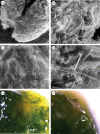Non-glandular trichomes of Solanum carolinense deter feeding by Manduca sexta caterpillars and cause damage to the gut peritrophic matrix
- PMID: 28228510
- PMCID: PMC5326521
- DOI: 10.1098/rspb.2016.2323
Non-glandular trichomes of Solanum carolinense deter feeding by Manduca sexta caterpillars and cause damage to the gut peritrophic matrix
Abstract
Plant trichomes constitute a first line of defence against insect herbivores. The pre- and post-ingestive defensive functions of glandular trichomes are well documented and include direct toxicity, adhesion, antinutrition and defence gene induction. By contrast, the defensive functions of non-glandular trichomes are less well characterized, although these structures are thought to serve as physical barriers that impede herbivore feeding and movement. We experimentally varied the density of stellate non-glandular trichomes in several ways to explore their pre- and post-ingestive effects on herbivores. Larvae of Manduca sexta (Sphingidae) initiated feeding faster and gained more weight on Solanum carolinense (Solanaceae) leaves having lower trichome densities (or experimentally removed trichomes) than on leaves having higher trichome densities. Adding trichomes to artificial diet also deterred feeding and adversely affected caterpillar growth relative to controls. Scanning electron and light microscopy revealed that the ingestion of stellate trichomes by M. sexta caterpillars caused extensive damage to the peritrophic membrane, a gut lining that is essential to digestion and pathogen isolation. These findings suggest that, in addition to acting as a physical barrier to deter feeding, trichomes can inhibit caterpillar growth and development via post-ingestive effects.
Keywords: Manduca sexta; Solanum carolinense; herbivory; peritrophic matrix; plant defence; trichomes.
© 2017 The Author(s).
Figures





Similar articles
-
Plant spines deter herbivory by restricting caterpillar movement.Biol Lett. 2017 May;13(5):20170176. doi: 10.1098/rsbl.2017.0176. Biol Lett. 2017. PMID: 28490447 Free PMC article.
-
Leaf trichomes affect caterpillar feeding in an instar-specific manner.Commun Integr Biol. 2018 Aug 9;11(3):1-6. doi: 10.1080/19420889.2018.1486653. eCollection 2018. Commun Integr Biol. 2018. PMID: 30214672 Free PMC article.
-
Constitutive and herbivore-induced structural defenses are compromised by inbreeding in Solanum carolinense (Solanaceae).Am J Bot. 2013 Jun;100(6):1014-21. doi: 10.3732/ajb.1200612. Epub 2013 Apr 1. Am J Bot. 2013. PMID: 23545253
-
Plant inbreeding and prior herbivory influence the attraction of caterpillars (Manduca sexta) to odors of the host plant Solanum carolinense (Solanaceae).Am J Bot. 2014 Feb;101(2):376-80. doi: 10.3732/ajb.1300295. Epub 2014 Feb 8. Am J Bot. 2014. PMID: 24509799
-
Plant glandular trichomes as targets for breeding or engineering of resistance to herbivores.Int J Mol Sci. 2012 Dec 12;13(12):17077-103. doi: 10.3390/ijms131217077. Int J Mol Sci. 2012. PMID: 23235331 Free PMC article. Review.
Cited by
-
Plant defenses interact with insect enteric bacteria by initiating a leaky gut syndrome.Proc Natl Acad Sci U S A. 2019 Aug 6;116(32):15991-15996. doi: 10.1073/pnas.1908748116. Epub 2019 Jul 22. Proc Natl Acad Sci U S A. 2019. PMID: 31332013 Free PMC article.
-
The pivotal roles of gut microbiota in insect plant interactions for sustainable pest management.NPJ Biofilms Microbiomes. 2023 Sep 21;9(1):66. doi: 10.1038/s41522-023-00435-y. NPJ Biofilms Microbiomes. 2023. PMID: 37735530 Free PMC article. Review.
-
Exposure to polyphenol-rich purple corn pericarp extract restricts fall armyworm (Spodoptera frugiperda) growth.Plant Signal Behav. 2020 Sep 1;15(9):1784545. doi: 10.1080/15592324.2020.1784545. Epub 2020 Jun 24. Plant Signal Behav. 2020. PMID: 32580616 Free PMC article.
-
Persistent inner tepals and wings protect developing seeds of Rheum nanum from insect herbivory in Central Asian cold deserts.Ecol Evol. 2024 Aug 15;14(8):e70179. doi: 10.1002/ece3.70179. eCollection 2024 Aug. Ecol Evol. 2024. PMID: 39149522 Free PMC article.
-
Trichomes mediate plant-herbivore interactions in two Cucurbitaceae species through pre- and post-ingestive ways.J Pest Sci (2004). 2023;96(3):1077-1089. doi: 10.1007/s10340-023-01611-x. Epub 2023 Mar 28. J Pest Sci (2004). 2023. PMID: 37168103 Free PMC article.
References
MeSH terms
Associated data
LinkOut - more resources
Full Text Sources
Other Literature Sources

